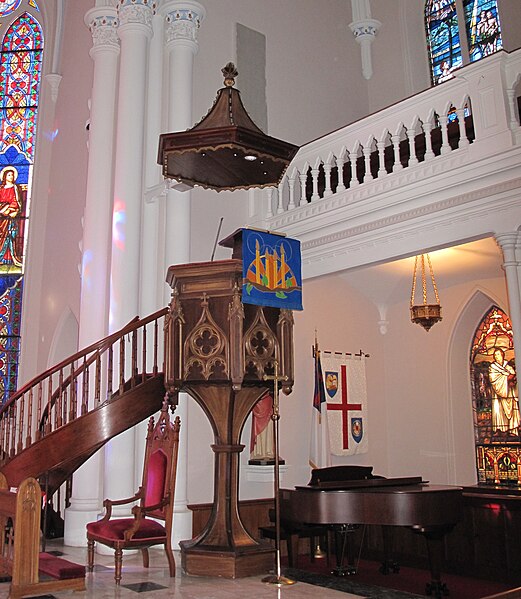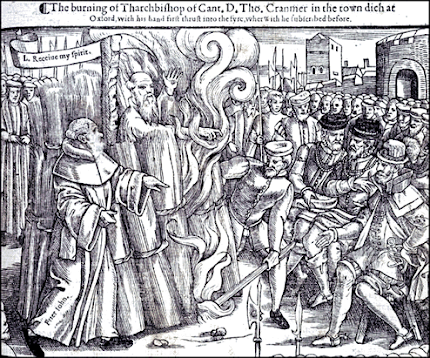This Sunday I visited my sister in Goose Creek, South Carolina. Seeing that I enjoy a good conservative Episcopal service, I decided to find a Reformed Episcopal church. Somehow my GPS directed me to an historical site where there is only one service conducted every year on the Sunday after Easter.
Several things I observed from the design of the sanctuary are notable. First of all, there was no altar but instead there is the Lord's table with no candles. Secondly the pulpit was elevated. The minister had to climb a spiral staircase to get to the pulpit. These two purposeful designs in the layout of the sanctuary alone tells me that at the time the church was built, namely around 1717 in the antebellum colonial days, there was not yet an Anglo-Catholic influence. The Church of England was still thoroughly Protestant and Reformed. Here are a couple of pictures I shot with my cellphone:
 |
| St. James Episcopal Church, Goose Creek, South Carolina. Established 1707. This building, 1717. |
Notice that there is no altar. There is a communion table with no candles on it. Also, the central feature of the sanctuary is the pulpit, emphasizing that the preaching of God's written Word, the Holy Scriptures are central to worship service. On the left of the pulpit is posted the Decalogue or Ten Commandments from Exodus 20:1-17.
On the right the other table posted begins with the model prayer taught by Jesus in Matthew 6:9-13 KJV. Of course, following the Bishop's Bible the words "debts" and "debtors" are replaced by "trespasses" and "those who trespass against us." Underneath that is the Apostles' Creed.
It should be noted here that in 1717 the 1662 Book of Common Prayer was still in use in the American colonies. That would mean that the Decalogue was read at every administration of the Lord's Supper. This is a tradition that is sorely lacking not only in modern Puritan churches but in Anglican churches as well. After every reading of the law there is a prayer asking for God to write this law in our "hearts". The meaning here is not that God would write the law of God in our emotions. Rather the emphasis is on memorizing the Scriptures "by heart" so that it is not forgotten. As a man thinketh in his heart so is he. (Proverbs 23:7).
The unfortunate thing is that after the Puritans were ejected from the Church of England the high church Carolingians, Laudians, and Arminians began to undermine the Reformed theology of Archbishop Thomas Cranmer and bishops Hugh Latimer and Nicolas Ridley. Calvinism was a part of the English Reformation early on and slowly that influence ebbed away because the Puritans were forced out of the church.
 |
| St. Matthew's German Evangelical Church (1872) in Charleston, SC |
Another thing to note in the picture above is the wooden hood hanging over the pulpit. Not only the elevation of the pulpit but this device above the preacher's head caused the sound of his voice to carry equally to all parts of the sanctuary. Not surprisingly, I could hear the minister as well here as I could have in larger sanctuary equipped with modern sound equipment. I cannot find the name of this object hanging above the pulpit. If anyone knows, please leave a comment below? I found another example of this at St. Matthew's German Evangelical Church (1872) in Charleston, SC, which you see to the left. (See also: Pulpits). [Addendum: Someone over at the Anglican Forums pointed out that the object above the pulpit is a "sounding board" or a "tester". This makes sense of the expression in common usage of using someone else as a "sounding board" to think through a problem. See: Sounding board.]
I suppose it could be argued that this elevation is solely for sound projection. But it also serves to show the authority of preaching in the church. This is particularly true where there is no altar against the back wall as the photo from St. James Episcopal Church above shows.
Here is another photo where I was standing in front of the pulpit. I only wish had more information about the community that founded this church. Also, there is a graveyard surrounding the church, which is typical for churches of the period.
 |
| Another shot of the pulpit from floor level. |
 |
| There is even a "pillar saint" buried under one of the columns. |
The minister who spoke was an African preacher, the Rev. Dr. Anthony Kowbeidu of St. Andrews Episcopal Church in Goose Creek, South Carolina. His sermon came from John 20:19-30. I was pleased that he emphasized that the resurrection is a real event and that the Scriptures are true. IF there is no resurrection our faith is in vain.
There was no communion but simply a morning prayer service, although there was only a loose adherence to the Book of Common Prayer. The opening Scripture sentences were completely missing, for example. Although I could give a few Clarkian remarks about Dr. Kowbeidu's emphasis on a personal relationship and feelings, I will forego that and leave off this post for now. I might make more posts tomorrow with more pictures.
May the peace of God be with you,







5 comments:
I have family in Charleston, SC and visiting, I have been encouraged by seeing Anglican sanctuaries with the 10 Commandments, the Lord's Prayer and the Apostles' Creed on large plaques. Thank-you for this posting. I think these days it is more important to have the 10 commandments in the Lord's House and not necessarily a court house.
Peace of Christ be with you,
Rev. Mark Schroeder,
Pastor at Concordia Lutheran Mission (LCMS)
Buena Vista, VA
I'm sorry to inform you, brother, that this is not an active congregation meeting here. I should have made note of that. Actually, this is a state historic site that marks one of the Episcopal churches from the colonial period. There is only one service there per year and many from mainline liberal churches show up for the services, including the liberal PCUSA. The minister I think was a bit more conservative than your typical Episcopal minister because he is from Africa. I myself am a 5 point Calvinist, which I'm sure you disagree with due to your Melanchthon theology in the Lutheran Church Missouri Synod. But I am glad that the LCMS is still fairly conservative and Evangelical. This picture was taken at an Eastern Sunday service. There was no sound system there and the sounding board above the pulpit actually worked very well to carry the sound of the minster's voice.
The peace of God be with you,
Charlie
I see nothing wrong with having the 10 commandments posted on courthouses because the founding fathers saw fit to have the 10 commandments engraved on the Supreme Court building in Washington, D.C. Secularism should not be the established religion of the U.S.A.
I didn't know what a sounding board was when I posted this originally.
Wikipedia: Sounding Board
Post a Comment